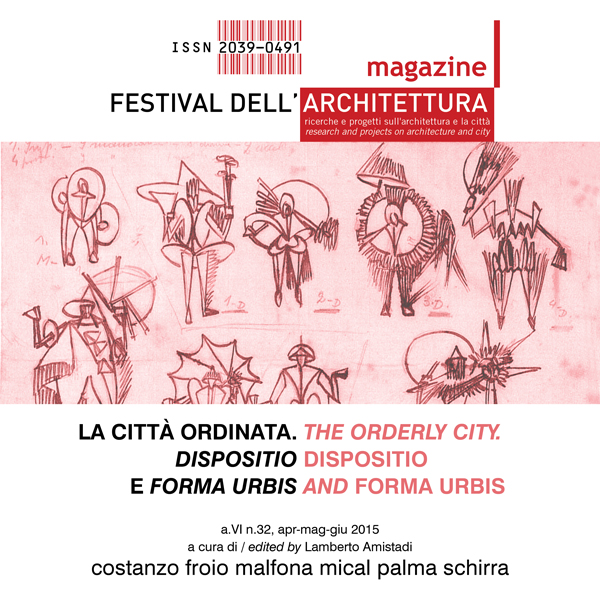Articoli
Pubblicato 2015-04-01
Parole chiave
- Dispositio,
- Soft Machine,
Come citare
Mical, T. (2015). La dispositio informale della "Soft Machine". FAMagazine. Ricerche E Progetti sull’architettura E La Città, (32), 68–75. https://doi.org/10.12838/fam/issn2039-0491/n32-2015/94
Abstract
Questo saggio affronta i termini concettuali e le conseguenze di una forma “soft” di dispositio vitruviana come possibilità attuale della relazione tra architettura e città. La tendenza verso il “morbido” e l'informale nell'architettura e nel progetto urbano genera nuove modulazioni concettuali del tessuto urbano. I processi sociali di assemblage di componenti corrispondono oggi ad un avanzamento, in cui una dispositio “soft” ordina le mutevoli fasi/spazi della vita urbana e sostituisce la precedente logica modernista astratta delle macchine, dello spazio striato e del determinismo funzionale.Riferimenti bibliografici
- William S. Burroughs, The Soft Machine, 1966
- Sigfried Giedion, Mechanisation Takes Command: A Contribution to Anonymous History, U. Minn. Press, 2014 (1948)
- Reinhold Martin, The Organizational Complex, MIT Press, 2005
- Stewart R. Clegg and Martin Kornberger (eds.), Space, Organizations and Management Theory, CBS Press, 2006
- Giora Hon, Bernard R. Goldstein, From Summetria to Symmetry: The Making of a Revolutionary Scientific Concept, Springer, 2008
- Felix Guattari, The Mechanic Unconscious, MIT Press, 2010
- Rosalind Krauss, The Optical Unconscious, MIT Press, 1993
- Frederick Jameson, The Political Unconscious, Cornell University Press, 1982
- Jonathan Hughes and Simon Sadler (eds), Non-Plan : Essays on Freedom, Participation and Change in Modern Architecture and Urbanism, Routledge, 2000
- Sean Lally, The Air From Other Planets: A Brief history of Architecture to Come, Lars Muller, 2003
- Peter Zumthor, Atmospheres, Birkhäuser Architecture, 2006
- P. Tidwell, Tapio Wirkkala, Architecture and Atmosphere, Rut Bryk Foundation, Espoo 2014
- Melissa Gregg and Gregory Seigworth (eds), The Affect Theory Reader, Duke UP, 2014
- Robert Kronenburg’s Flexible: Architecture that Responds to Change, Laurence King, 2007
- UN Studio, Design Models, Thames & Hudson, 2006
- Yuko Hasegawa, Kazuyo Sejima + Ryue Nishizawa: SANAA, Phaidon, 2006
- Cecil Balmond, Informal, Prestel, 2007
- Yves-Alain Bois and Rosalind Krauss, Formless: A User’s Guide, Zone, 2007
- Stan Allen, Points + Lines: Diagrams and Projects for the City, Princeton Architectural Press, 1999
- Manuel Delenda’s “Deleuze and the Use of the Genetic Algorithm in Architecture.” April 2001 (link alla pagina http://www.egs.edu/faculty/manuel-de-landa/articles/deleuze-genetic-algorithm-in-architecture/)
- John Rachjman, The Deleuze Connections, MIT Press, 2000
- Ignasi de Solà-Morales, Differences: Topographies of Contemporary Architecture, MIT Press, 1997
- Simone Brott, Architecture for a Free Subjectivity: Deleuze and Guattari at the Horizon of the Real, Ashgate, 2011
- Lars Spruybroek, The Architecture of Continuity: Essays and Conversations, V2_ publishing, 2008
- Manuel De Landa, “Meshworks, Hierarchies and Interfaces” in John Beckman (ed), The Virtual Dimension: Architecture, Representation, and Crash Culture, Princeton Architectural Press. 1998

